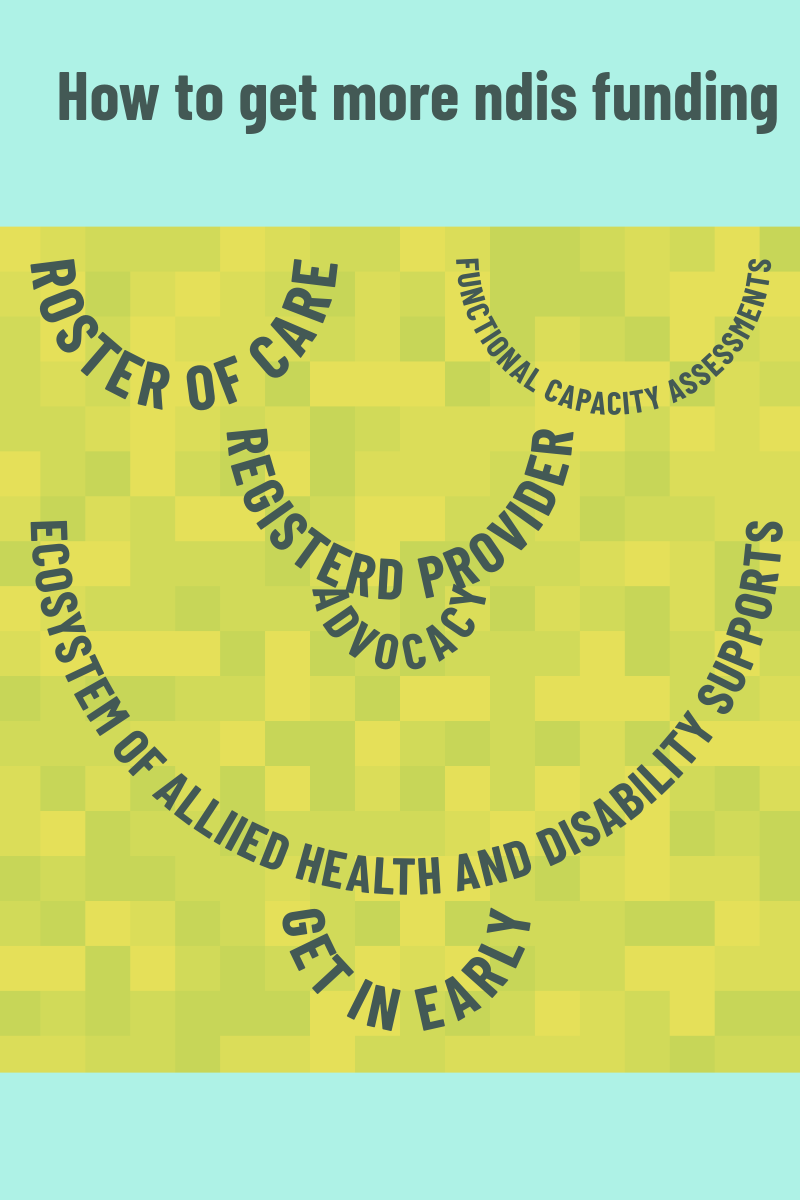How to get more NDIS funding 06.04.2024
If you’re coming up to an NDIS plan review or have requested a change in circumstances (COC) these are the top 10 ways to get more NDIS funding
- Get yourself an up to date, accurate Functional Capacity Assessment (FCA). An FCA is a summary of every facet of your life and how it is influenced by your disability completed by an Occupational Therapist. It paints a picture of you now, and your goals are for the future. If you’d like to know more click here. An FCA uses lots of different assessments in it to paint a picture in more clinical terms to spell out to the NDIS where you need assistance and how much of it if at all. Assessments you might see in an FCA include, and do not need to be alarmed by might include; Caregiver Burden Scale, WHODAS the list goes on, you can learn more about these here.
- Back it up with a ROC – Roster of Care. A roster of care is quite simply that. A fortnight or weekly snapshot of the time you receive daily living and community activity supports. There is a template for this you can download from the NDIS website, here.
- Be persistent. When your review submission or COC is submitted, start calling the NDIS. Be the noisy tin can. Have your NDIS number ready and get a receipt number for the call, if they can’t find your request, get them to search for it in the main email, and see where your request has progressed to.
- Utilise advocacy services. If you’re not feeling heard, there are plenty of advocacy services funded by government grants for people with disability and even delivered by people with disability. They often have wait lists and can be hard to get into, so get in early and find a person that understands you and your disability and is assertive.
- Authroise someone to act on your behalf. This has got to be one of the most important things anyone in the scheme can do. If there is someone in your life that you trust to help with the heavy lifting dealing with the NDIS, then add them, you can do this via phone or form here. There is nothing better than being able to hand over the phone to someone you love and trust to someone at the NDIS who isn’t listening.
- Get all your ducks in a row. Literally. Get everything you’ve got and put it together. Read it or get assistance to read and understand it. Get it reviewed. Ask a loved one or someone you trust – does this paint a picture of me and my needs now in my life? Does the support recommended cover my needs? Does it support those who support me to keep doing so in the way we want.
- Start nearly. The review process takes time. Lots of time and lots of energy. If something isn’t working in your current NDIS plan, don’t wait to request a report from your Occupational Therapist or your provider or Allied Health team. These can sometimes between waitlist and availability of therapist with a background in your specific disability take months to get and complete. Don’t waste time getting started.
- Look at who is providing your current supports. Are you getting the most value? Are you being charged for silly things, like a call you didn’t answer or a message left on your phone? Take a good look at your Service Agreement and your client handbook. Are you getting what you’re told your getting? Is it meeting your needs. If not, shop around! Don’t hang around being pissed off with a service you don’t actually love.
- Look for a provider that serves as an ecosystem of disability and allied health services. Why? Because if the Occupational Therapist doing your FCA is in the same office as the person who is managing your supports, chances are they’ll have a chat and bounce ideas off each other and know your needs. They’ll both know who your support staff are, what your goals are, and what you want to be doing with your life.
- Find a registered provider that has everything at their fingertips. The whole reason the NDIS quality and safeguards commission exists, is to develop and improve services to people with disability. It might seem counterintuitive to pay more to a registered provider then to a private contractor, but it’s not your job to save the scheme money. It’s really not. If you need ten hours a day of support, then whether you get it at $40 or $60, is the NDIS’s job to fund at the nominated rate in the NDIS Price Guide. Why? Because the beautiful sub-contractor or independent support worker you have now might not always be around, you might move, or they might, or things might change and you might need a provider with more resources available, for a while, and that’s ok! The last thing you want is to be chasing a plan review because you’ve spent years spending the equivalent price guide amount of five hours a day when you need ten.
Remember, maximizing your NDIS funding involves persistence, preparation, and effective communication. By following these steps, you can advocate for the support you and your loved ones need to enjoy quality of life with disability.


